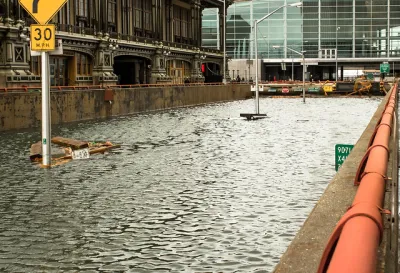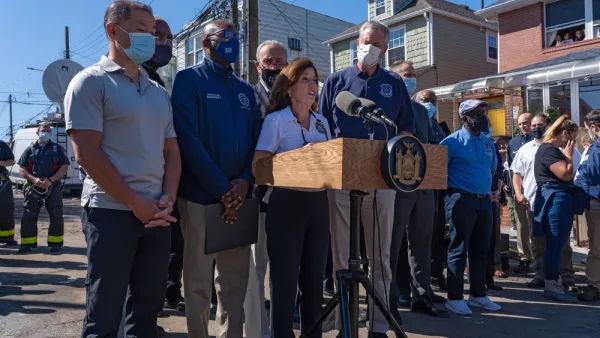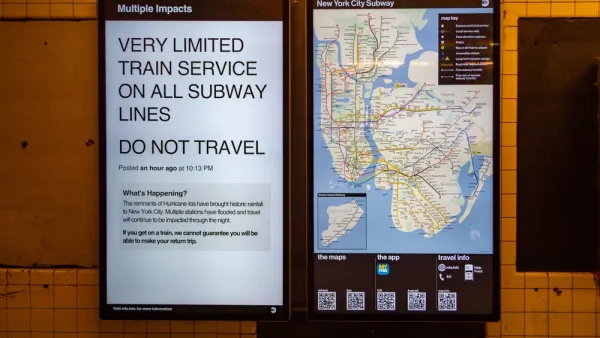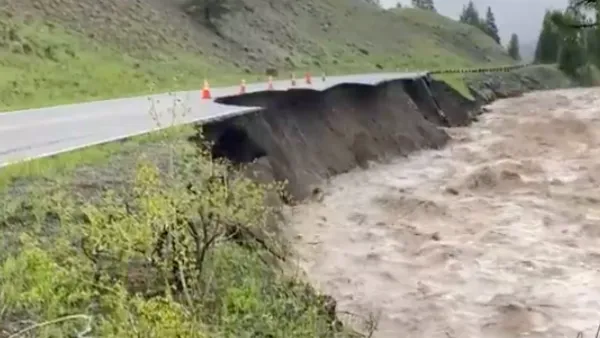The city must take urgent action to mitigate the effects of increasingly damaging rainstorms.

The flooding caused by Hurricane Ida and other storms signals a new normal for the Northeast, writes Henry Grabar, and cities like New York must prepare for more destructive rainstorms. "Climate change is making more intense rainstorms more frequent, particularly in the Northeast, and the expectations that such a storm would occur once a millennium are now obsolete." Earlier this year, "New York released its first-ever analysis of how to prepare for stormwater flooding," including goals such as to "[i]nform the public about flood vulnerability from extreme rain" and "continue developing a citywide hydrologic and hydraulic (H&H) model to better estimate runoff flow for various climate scenarios to be included in the drainage planning process."
But to date, the city has not taken much action to mitigate the potential effects of floods. Grabar outlines some solutions that could be implemented immediately "to mitigate the effects of extreme rainfall" and reduce the deaths and destruction caused by storms. The suggestions include planting more trees; improving drainage with bigger pipes and trash receptacles to keep drainage pipes clear; elevating vulnerable subway entrances and grates to protect them from stormwater; legalizing basement apartments to improve standards and safety for residents; and, perhaps most importantly, doing all of these things quickly, before another catastrophic storm has a chance to cause more damage. "The next rainstorm isn’t going to wait for the community board, and it’s certainly not waiting 1,000 years."
FULL STORY: What New York City Can Do Right Now to Prepare for the Next Biblical Rainstorm

National Parks Layoffs Will Cause Communities to Lose Billions
Thousands of essential park workers were laid off this week, just before the busy spring break season.

Retro-silient?: America’s First “Eco-burb,” The Woodlands Turns 50
A master-planned community north of Houston offers lessons on green infrastructure and resilient design, but falls short of its founder’s lofty affordability and walkability goals.

Delivering for America Plan Will Downgrade Mail Service in at Least 49.5 Percent of Zip Codes
Republican and Democrat lawmakers criticize the plan for its disproportionate negative impact on rural communities.

Test News Post 1
This is a summary

Test News Headline 46
Test for the image on the front page.

Balancing Bombs and Butterflies: How the National Guard Protects a Rare Species
The National Guard at Fort Indiantown Gap uses GIS technology and land management strategies to balance military training with conservation efforts, ensuring the survival of the rare eastern regal fritillary butterfly.
Urban Design for Planners 1: Software Tools
This six-course series explores essential urban design concepts using open source software and equips planners with the tools they need to participate fully in the urban design process.
Planning for Universal Design
Learn the tools for implementing Universal Design in planning regulations.
EMC Planning Group, Inc.
Planetizen
Planetizen
Mpact (formerly Rail~Volution)
Great Falls Development Authority, Inc.
HUDs Office of Policy Development and Research
NYU Wagner Graduate School of Public Service





























